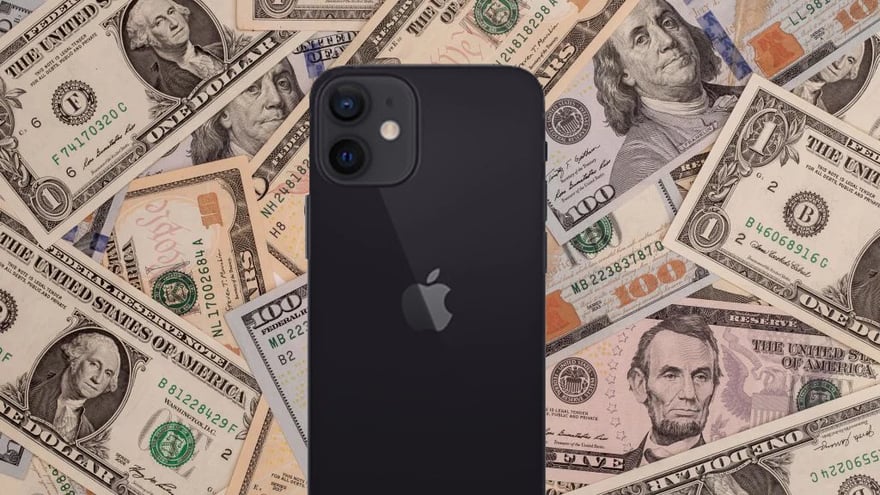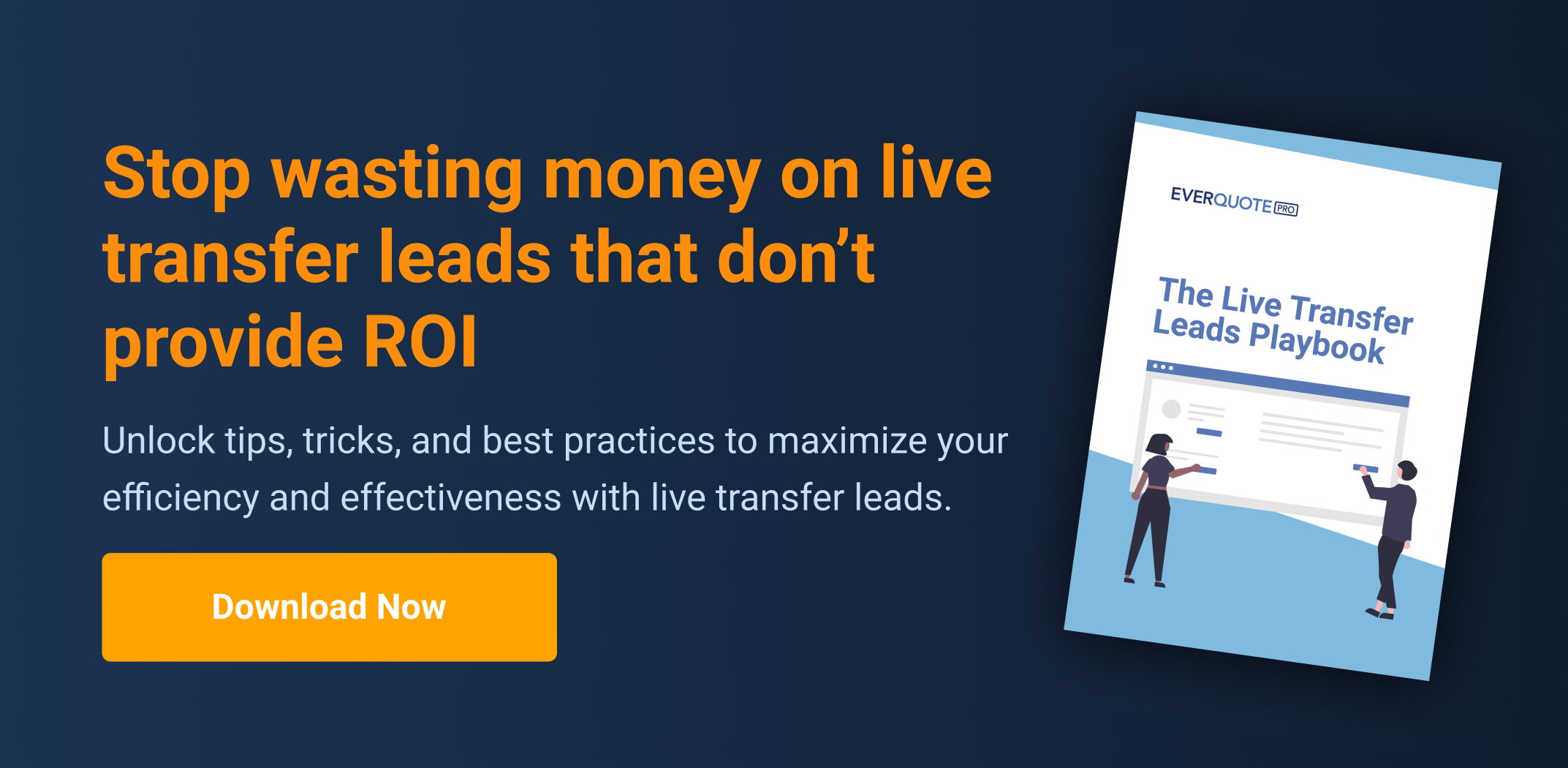
Live transfer leads (or “insurance calls”) are often written off as "too expensive" by many insurance agents. However, when you dig into the data and look at the ROI, insurance calls can (and do) generate positive returns and play a crucial role in the business strategy of thousands of growth minded agents. It all depends on how you are incorporating insurance calls into your overall marketing mix (and of course your sales process).
In this article, we’ll share a highly effective framework and simple formula that you can employ at your agency today to analyze the impact and overall ROI of calls.
Insurance Calls and “Sticker Shock”
Oftentimes I speak with insurance agents who swear by traditional data leads. They’ll have developed an efficient and effective process to work their leads, will have extensively trained their team members to work these leads and will have gotten full buy-in from all their producers. This is especially true once they’ve seen consistent results month after month, year after year. Agents who fall into this category tend to want to avoid anything that will “rock the boat” or potentially jeopardize the hard won balance they’ve painstakingly developed and the consistently low cost-per-bind that they’ve achieved.
Agents who fall into this category may purposefully stay away from live transfer calls. The most common reason I hear for this “the cost is just too high!” I understand where they’re coming from –the price of a data lead is typically a fraction of the cost of an insurance call.
But when you take a step back and really start to look at the bigger picture and calculate what I like to call the “cost per conversation,” calls become a much more intriguing option. And when you really start to take into account all the time and effort spent trying to get consumers on the phone with data leads, and calculate that into your ROI analysis, insurance calls start to seem like a much bigger bargain than the sticker price would have you initially believe.
What is the “Cost-Per-Conversation?”
Simply put the “cost-per-conversation” is how much you are spending (on average) for each conversation you have with an insurance prospect. It’s no secret that just because you’ve paid for a lead, it doesn’t guarantee that you will end up having a conversation with that particular consumer. So cost-per-conversation gives you a clear insight into how much you are actually spending to engage with an insurance shopper.
If you are using data leads, your cost-per-conversation can vary widely depending on a range of factors including the vendor, the lead quality, your speed-to-contact with leads, your follow-up process, your team’s experience and acumen with prospecting, and of course the lead cost. But with insurance calls your cost-per-conversation is essentially stable. Because calls deliver you a prospect ready to have a conversation, there is very little room for variation. With insurance calls the cost of the call is your cost-per-conversation.
How to Figure Out Your “Cost-Per-Conversation” with Leads?
While determining your cost-per-conversation with insurance calls is straightforward, it’s only slightly more complicated when it comes to data leads. To start you need to figure out how many calls (on average) it takes you or your producers to engage a lead in a conversation. You can calculate this on a daily, weekly, monthly, quarterly, even yearly basis, but to start, a monthly basis is probably the most straightforward.
Then to calculate the average number of calls per conversation (your “Call-per-Conversation Ratio”), you simply take the number of calls your team made over a given month, and divide that figure by the number of conversations you had with the leads you dialed. Just make sure that you are not including follow-up conversations with the same leads (2nd, 3rd, etc. conversations with the same lead).
So for example, if you purchased 200 data leads in a month and your producers ended up having 20 conversations with those leads (not including follow-up conversations), you would be averaging 10 leads per conversation.
Then to determine your “cost-per-conversation” you would just multiply your lead cost by 10 to figure out the “cost per conversation.” So if your average lead cost is $10, your cost-per-conversation would be $100.
To recap:
- # of Calls (per week, month, etc.) / (divided by) # of Conversations (per week, month, etc.) = Call-per-Conversation Ratio
- Call-per-Conversation Ratio x (multiplied by) Average Lead Cost = Cost-per-Conversation
How to Figure Out Your ROI with Leads?
To calculate your ROI for every dollar spent on a specific lead source, you’ll need to identify these primary data points:
- Total # of Leads Purchased
- Total # of Leads Closed
- Cost Per Lead (Average)
- Total Premium Written
- Commission %
Then, you’ll need to take those data points and calculate these secondary data points:
- Average Close Rate = Total # of Leads Closed / (divided by) Total # of Leads Purchased
- Total Cost of Leads = Cost Per Lead (Average) x (multiplied by) Total # of Leads Purchased
- Average Cost Per Sale = Total Cost / (divided by) Total # of Leads Closed
- Average Commission Per Sale = Total Premium Written x (multiplied by) Commission % (represented as 0.XY – so 15% = 0.15) / (divided by) Total # of Leads Closed
Finally, you take those secondary data points and plug them into this ROI equation:
- ROI (on Each Dollar Spent) = Average Commission Per Sale / (divided by) Average Cost Per Sale
So if Total # of Leads Purchased = 200
Total # of Leads Closed = 10
Cost Per Lead (Average) = $10
Total Premium Written = $20,000
Commission % = 15%
Step by Step ROI Calculation
First calculate the Average Close Rate, so 10 / 200 = 5%
Then, calculate the Average Cost Per Sale – so 1 / 5 x 200 = $200
Next, calculate the Average Commission Per Sale – so $20,000 x 0.15 / 10 = $300
Finally, calculate the ROI (on Each Dollar Spent) – so 300 / 200 = $1.50
You can use this useful insurance leads ROI calculator from Insurance Splash: download ROI calculator worksheet
Why Insurance Calls Can Lead to a Higher ROI
Take the previous example we discussed where an agent is seeing a $100 cost-per-conversation ($10 average data lead cost, with one conversation generated out of every 10 x leads). Now with an insurance call, since you’re getting a live prospect transferred to your phone you are guaranteed to have a conversation. Again, the cost-per-conversation is straightforward – it’s whatever the insurance call costs. So in the previous example, if an insurance call costs less than $100, you’re already seeing a better “cost-per-conversation” with calls than with leads.
And that’s not including the time spent by you or your producers to make the calls required to engage your leads in conversation. Looking at the bigger picture, this is where calls can really provide a superior ROI. Think about it – how much time does your team spend dialing leads each day/week/month to engage consumers in quality conversations? With a call there’s no dialing – the conversation is delivered to you. If it takes a producer 10 calls to engage a lead in conversation, and assuming an average of about 5 minutes is spent per call, that’s almost an hour in labor required to generate a conversation. That hour has a cost associated with it – not only the producer’s base salary/wage, but also with the producer being diverted from other revenue-generating activities like up-selling or cross selling.
And with EverQuote live transfers, you have 2 minutes from the time you receive a transferred call to decide whether to keep or reject the call. So if you determine the prospect isn't a fit within that initial 2 minute window, you can simply reject the call and you are not charged. To take advantage of this 2 minute window, you should develop a list of "knock-out questions" to ask and quickly assess if the transferred call is worth keeping. With data leads you don't get an opportunity to ask the lead knock-out questions, you just get the data [make sure to check out our Live Transfer Leads Playbook for some great "knock-out questions" you can use].
And once a producer connects with a data lead, they may end up spending 10+ minutes on the phone with them just to find out that they aren't qualified or not even interested in insurance shopping (or maybe they just talked about their favorite football team)! But with EverQuote calls, your cost per conversation is already lower and you can avoid losing all that time as you have a chance to vet a call's quality before you're even billed!
That's pretty unique and it makes every conversation your producers have over 2 minutes meaningful. All in all, this leads to better, higher quality conversations per every dollar spent.
Download our free Live Transfer Leads Playbook to get more proven strategies for handling these types of leads, along with:
- Example “knockout” questions to quickly qualify or disqualify leads
- Live transfer script samples
- Advice on choosing the right live transfer leads for your agency
Use our Live Transfer Leads Playbook and help set your agency up for success with live transfer calls! Just click the link below to get it!















